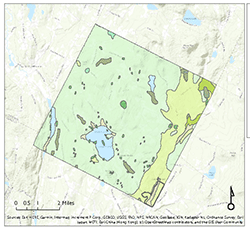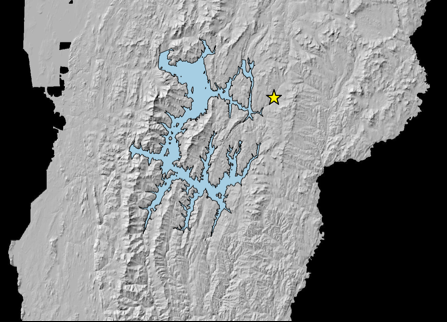Greensboro Bend
Surficial Geology

Surficial Geology map
The undulations of the countryside are the product of glaciers inch-worming across the landscape. In their wake, they leave glacial deposits and landforms comprised of clay, silt, sand, pebbles, cobbles, and boulders. Most of Vermont, Greensboro included, is covered in a layer of glacial till—an unsorted mix of sediment sizes. Surficial deposits provide the “parent material” for the overlying soils. Patterns in the bedrock geology, surficial geology, and soils layers influence the distribution of plant communities and agricultural lands.
3 million years ago
Vermont’s last ice age began 3 million years ago; during this time, glaciers advanced and retreated across North America. During the last glacial advance, the Laurentide ice sheet covered the entirety of Vermont and was over a mile thick. As the ice sheet flowed across Vermont, it eroded the underlying rocks. Much of this eroded material accumulated beneath the ice sheet and was exposed when the ice sheet retreated, leaving glacial till in its wake. The Greensboro Bend valley was likely widened and deepened when ice flowed along it.
Life at the time: saber-toothed cats, zebras, elephants, and mammoths.
14,100 years ago

Glacial Lake Winooski Extent | Source: Stephen Wright
Glacial meltwater from the retreating Laurentide ice sheet likely created a high-energy environment in Greensboro Bend. Glacial Lake Winooski, the largest glacial lake in Vermont’s mountains, could have been dammed in Greensboro Bend at some point; the Hardwick-Greensboro area was its northernmost reach. Delta sands, built up at the mouths of rivers, and eskers—deposits formed by streams that flow within or under glaciers—formed the surficial sediments in Greensboro Bend.
Life at the time: large mammals—woolly mammoths, mastodons, elk, dire wolves, and giant beaver.
Works Consulted
A Correlated History of Earth. (2013). Afton, Minnesota: Pan Terra, Inc.
Dunlavey, M. (2016). A Timeline of Vermont’s Bedrock Geology for the Field Naturalist & Ecological Planning Program.
Wright, S. (2019, February 22). Personal Interview.